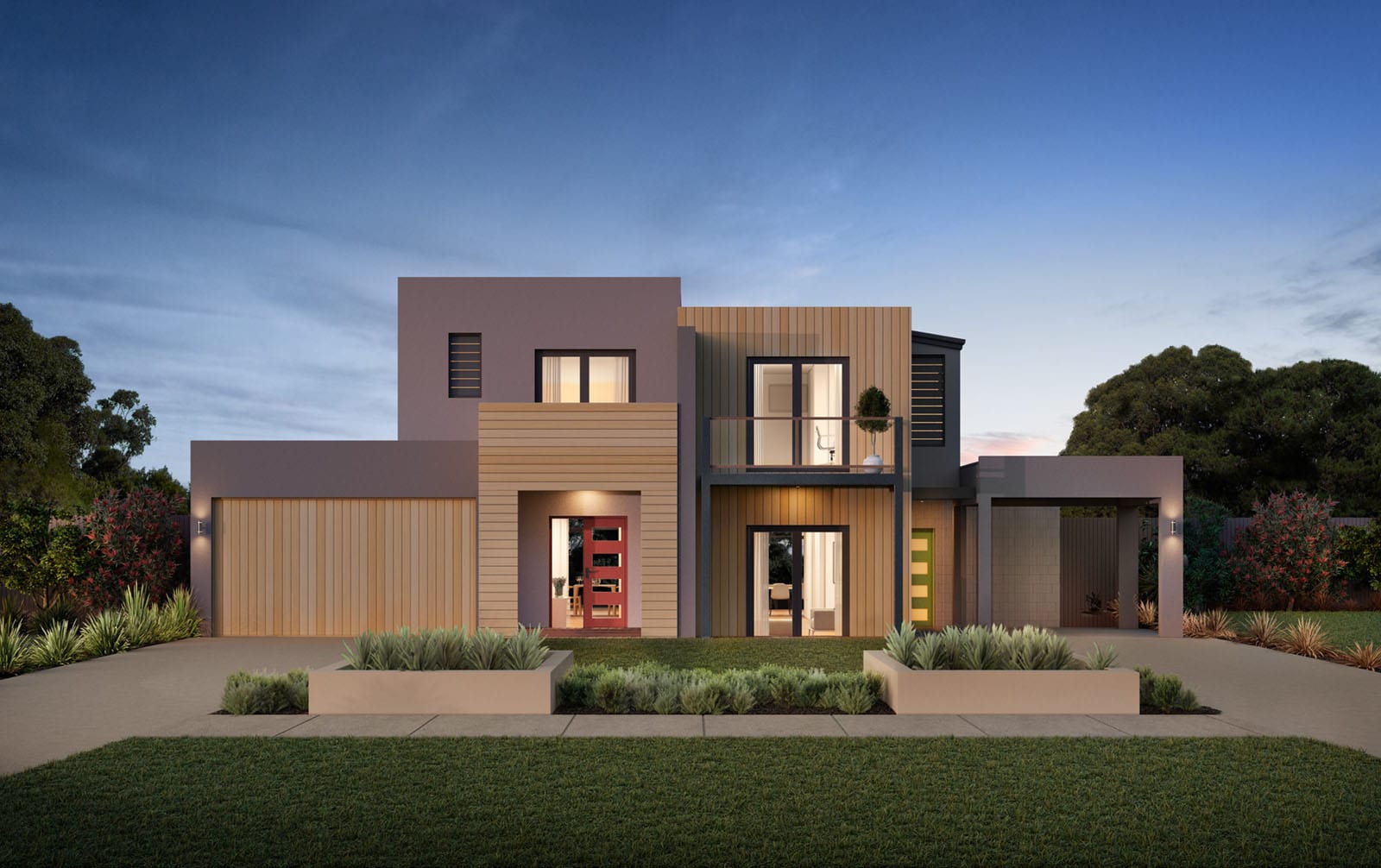Dual Occupancy Builders Melbourne
Capitalise on your block of land with the help of premium dual occupancy builders, Forme Homes. With decades of building knowledge, Forme is a leader in the industry specialising in duplex and dual occupancy developments. The design and construction team offers end-to-end service, from the initial concept to the delivery of your dream home. Whether for investment or owner occupation, dual occupancy is the ideal solution for your block and offers a high return on investment. Dual occupancy provides the perfect space for multigenerational living and maximises the use of your land by either knockdown rebuilds or building on a new block of land. With their unparalleled experience in dual occupancy development, Forme Homes have delivered many designs and customised options to satisfied customers across Melbourne and the southeast.
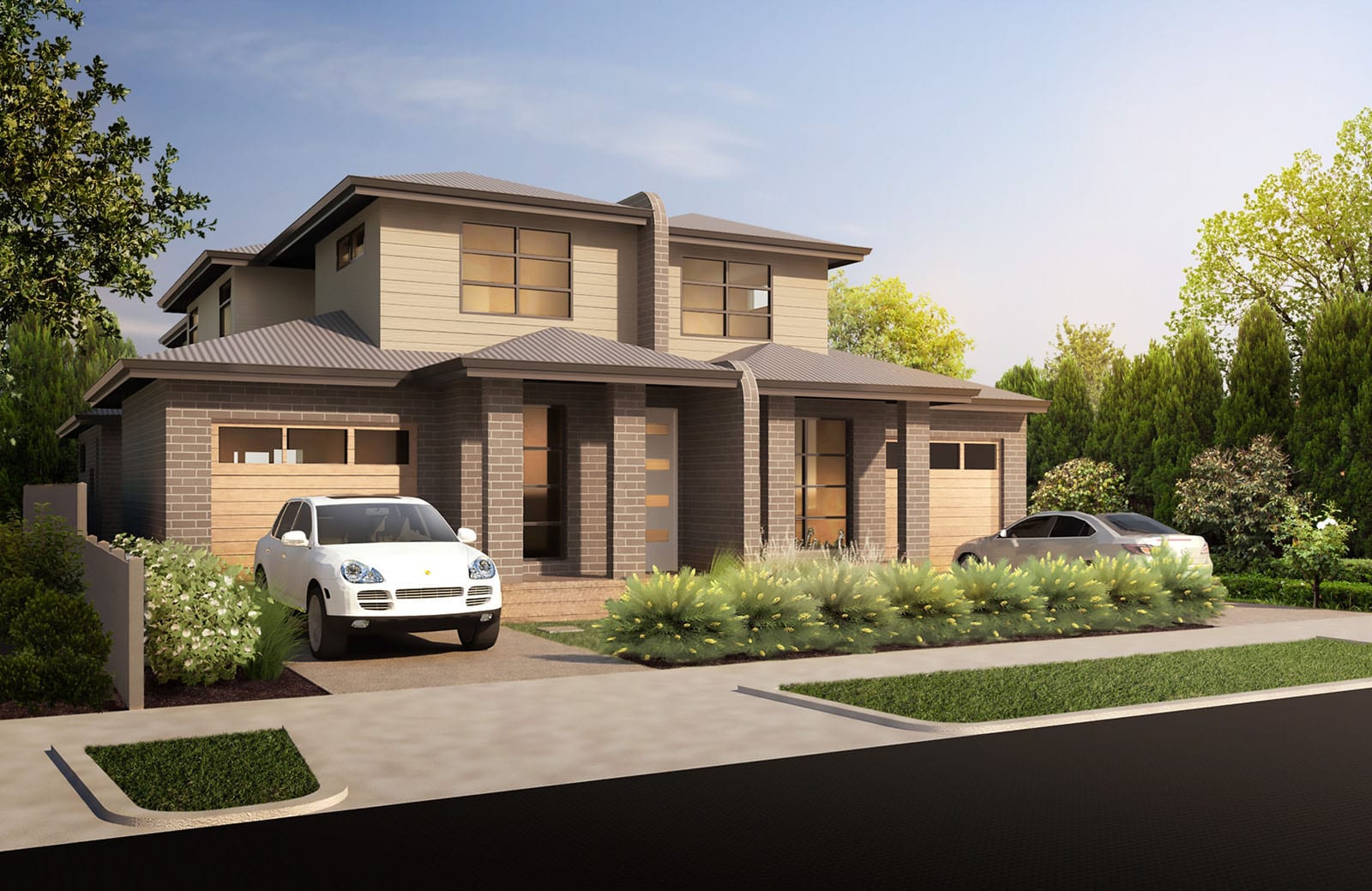
Capitalise on your block of land with the help of premium dual occupancy builders, Forme Homes. With decades of building knowledge, Forme is a leader in the industry specialising in duplex and dual occupancy developments. The design and construction team offers end-to-end service, from the initial concept to the delivery of your dream home. Whether for investment or owner occupation, dual occupancy is the ideal solution for your block and offers a high return on investment. Dual occupancy provides the perfect space for multigenerational living and maximises the use of your land by either knockdown rebuilds or building on a new block of land. With their unparalleled experience in dual occupancy development, Forme Homes have delivered many designs and customised options to satisfied customers across Melbourne and the southeast.


What is a Dual Occupancy Home?
The dual occupancy movement is growing across Melbourne, with thousands of people choosing to reconfigure their homes into two distinct dwellings. Simply put, a dual occupancy house is where there are two dwellings on one land allotment. There are two types of dual occupancy – attached and detached. An example of an attached dual occupancy house would be two houses under the same roofline with the same street frontage. An example of a detached dual occupancy house would be one house behind another as a separate structure with a shared driveway.


Difference between Dual Occupancy and Duplex
There seem to be many misconceptions about the difference between dual occupancy and duplex, but, in reality, the distinction is quite simple. They are both two homes on one block, but the construction options and subdivision laws are different.
As stated above, dual occupancy means two homes on one block with one title. A duplex is also two properties on one block but, unlike a dual occupancy, has two separate titles and can be sold separately. A big difference between a dual occupancy and a duplex is a duplex cannot be constructed as a detached dwelling. To qualify as a duplex, the dwellings must be connected by a central wall or roof and yet are legally considered two separate residences. If you build an attached dual occupancy house on a single title of land, you can apply to subdivide that single piece of land into two separate land titles, turning that property into a duplex.
Dual Occupancy Home Designs
There are a number of different designs and styles when considering a new dual occupancy home.
Opting for a higher-density living arrangement is attractive to investors and owner-occupiers, particularly in a competitive rental and real estate climate. The benefits of dual occupancy are numerous. Investors are guaranteed an optimised return on investment, while owner-occupiers can maximise the use of their land, create living space for multiple generations, and reap the financial rewards of sharing the mortgage and living expenses.
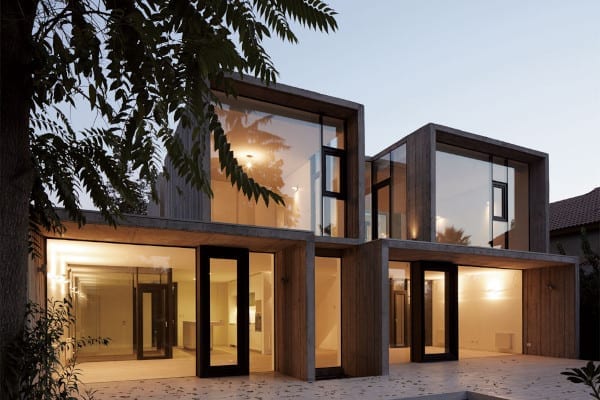
Project Designs
Different Ways to Build a Dual Occupancy Home
For anyone wanting to realise the potential of their land and get two houses on one plot of land, it is critical to understand the options for building a dual-occupancy home. Forme Homes offers various alternatives to choose from, including a knockdown rebuild, building a second home on your property, dividing a house into two, or building a new custom dual occupancy home from the ground up.
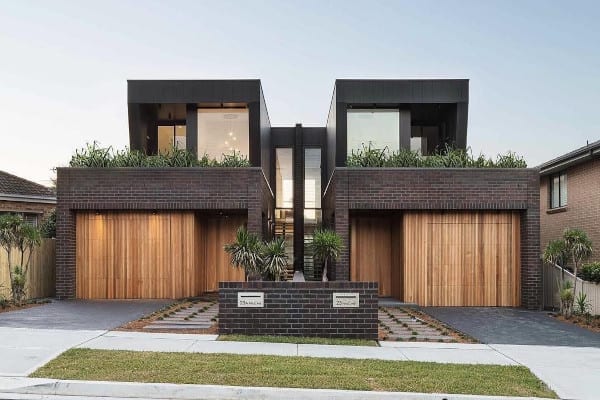
Knockdown rebuild.
A knockdown rebuild is the process of knocking down and rebuilding a dwelling instead of renovating. You would consider a knockdown-rebuild to build a dual occupancy home if the land value was higher than other places, the block would accommodate two homes, or you wanted to stay in the area. You could knock down the home and rebuild a duplex, townhouse, or two homes on one block of land.
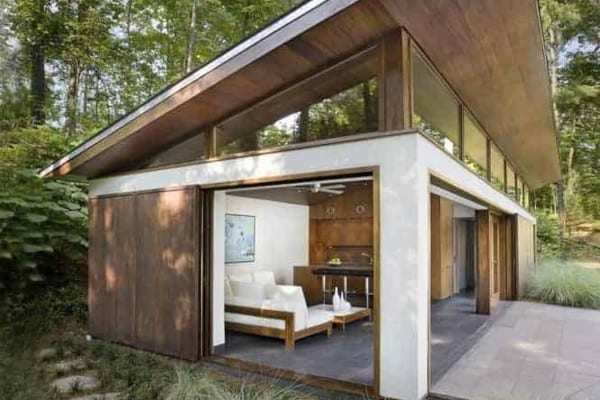
Building a second home on your property.
If your block is suitable, you will have the option of building a second home on your property. Building a second home requires acquiring development permission and other appropriate approvals and can be quite complicated. It is still possible, however, with the help of experts like Forme Homes to guide you through the process. A second home on a property could be a dependent person unit or another dwelling and will still fall under the dual occupancy banner if it is on the one title.
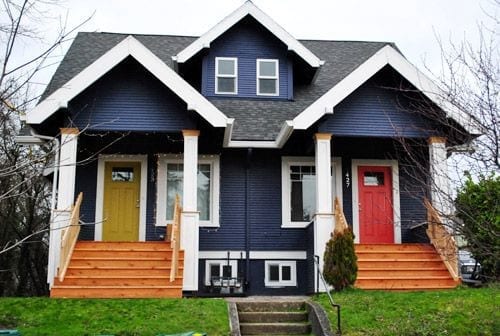
Dividing a house in two.
You can renovate an existing house by dividing it into two or more dwellings. Splitting a home in two could be an option, but it will still require the assistance of a qualified builder and designer to determine the project’s viability and guide you through the building and planning permit application process. Builders like Forme Homes are highly qualified in this conversion style and have a keen eye for maximising this kind of space with the least amount of structural intervention.
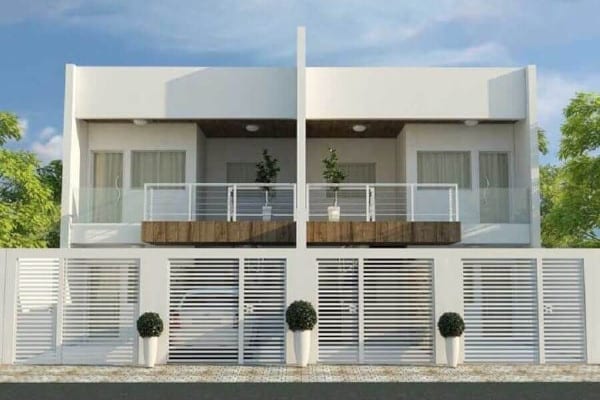
Custom build.
By building a purpose-built custom home, you can design and plan your dual occupancy project to your exact specifications. The in-house team of designers and builders at Forme Homes will customise the home to suit your needs while considering the block of land features.
What Is The Process of Building a Dual Occupancy Home?
- Initial consultation with Forme Homes. The initial consultation with Forme is free of charge. Here you will discuss your ideas for the dual occupancy home, potential design options and costs, and your budget to give the team a good understanding of the brief.
- Assess your block. Whether a new block or a block with an existing home, we must establish that dual occupancy is possible and affordable, so a site assessment is necessary. Forme Homes will guide you through the process, evaluating the property, council regulations and codes, and working out how to best maximise your land.
- Design concept plan. After establishing the viability of the building on your block, the Forme in-house design team will work with you to design a floor plan and choose a facade. The experienced team will take into account your requirements as well as the specifications of the block and any council restrictions.
- Sign preliminary contracts. Once you are satisfied with the design and costs, the team will assemble a preliminary contract for you to sign. This allows them to start preparing town planning and conducting land surveys and soil tests.
- Choose external style & colours. As part of the town planning process, final external colours must be chosen. These include the facade, side, and rear of the home. The overall external appearance of the home is finalised to be submitted to the council for approval.
- Sign formal building contracts. Once the town planning is approved and the council’s permits have been obtained, it is time to sign the formal building contract.
- Choose internal fixtures and fittings. With the assurance of council approvals, you can choose your interior colour theme, fixtures, and fittings. For two different homes, you can decide if you want the decor to be the same or choose different colour palettes and interior finishes. If you are planning on living in one of the houses and renting or selling the other, one option is to put higher quality fixtures in your own residence and basic fixtures and fittings in the second dwelling.
For a more in-depth look at the whole design process, please read through our article on the topic here: Designing Your Own Home. - Construction. With a clear lot, the dual occupancy build can begin. Forme Homes project managers work with you throughout the construction process, keeping you informed every step of the way.
For a more in-depth look at the whole build process, please read through our article on the topic here: Stages of Building a Home.

Important Factors To Consider Before Building A Dual Occupancy
With an understanding of the different features of a dual occupancy home, there are several factors still to be considered before choosing a style. Often the type of dual occupancy home you build will be determined by these factors.
- Land size requirements. To build a dual occupancy, blocks typically need to be at least 600 square metres in area and at least 15 metres wide. The different configurations of dual occupancy homes mean the average measurements for a dual occupancy design are required to be 15.25m wide and 44 metres deep.
- Block specifications. The type of development you are allowed to build will depend on the block’s features, including topography, orientation, the streetscape, and the type of buildings abutting the boundary.
- Title & Zoning. The zoning regulations of the council will affect the type of dual occupancy home you can build. Fortunately, most councils allow dual occupancy builds, provided no covenants exist on the land.
- Plans & Permits. Planning documents and building permits are required to build a dual occupancy home. A planning permit allows a certain use or development to proceed on a specified parcel of land which can impact the style of dual occupancy you can build.
- Finance. Avoid over-committing financially by building a style of dual occupancy you can afford. This may impact your choice to build a duplex (which is more affordable) versus two homes on one block.
- Reason for building. Considering the motivation for building a dual occupancy can impact the style you choose. If it is to accommodate grandparents, a dependent person unit or separate house on the same block might be a good option. If it is an investment, perhaps building a duplex is more cost-effective with the likelihood of higher returns.
Frequently Asked Questions
Is building a dual occupancy home a good investment?
Dual occupancy homes are an excellent investment. Having two properties on the one block means twice the rental yield or a better return on selling.
How do I know if my block is suitable for dual occupancy?
The best thing to do is seek advice from the team at Forme Homes regarding council regulations. However, as a rule, block size needs to be on a minimum sized block of 635sqm and have a minimum frontage of 12 metres.
How much does it cost to build a dual occupancy home?
An estimate of the development costs for a dual occupancy home range between $80k – $120k, with building costs on top of that. The full cost will depend on the type of dual occupancy construction, the size of the properties and types of fittings and fixtures chosen.
How long does it take to build a dual occupancy home?
Depending on the development, the timeline varies but, for an average two unit project the estimated time is 18-24 months.
What permits are needed to build a dual occupancy home?
A town planning permit and building permit need to be obtained. The town planning permit is granted from the local council which is written approval saying you are allowed to develop the land in a certain way. The building permit is an approval by a surveyor that the building design complies with building regulations. Forme Homes can advise on permits and approvals and apply on your behalf.
Do you build on flat blocks, or can you build on sloping blocks too?
Dual occupancy homes can be built on sloping blocks, depending on the style and design. Forme Homes can advise on the best site and design for your dual occupancy home.
Which areas do you service?
Forme Homes service Melbourne, south-east Melbourne and the Mornington Peninsula.
Can you use my plans to build?
Forme Homes can use your own plans, and also have a full in-house design team.
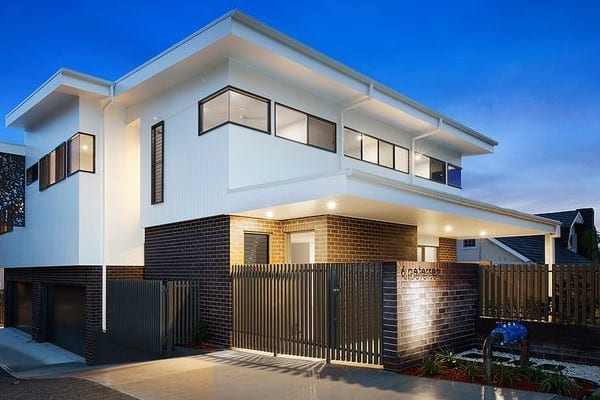

Client Testimonials
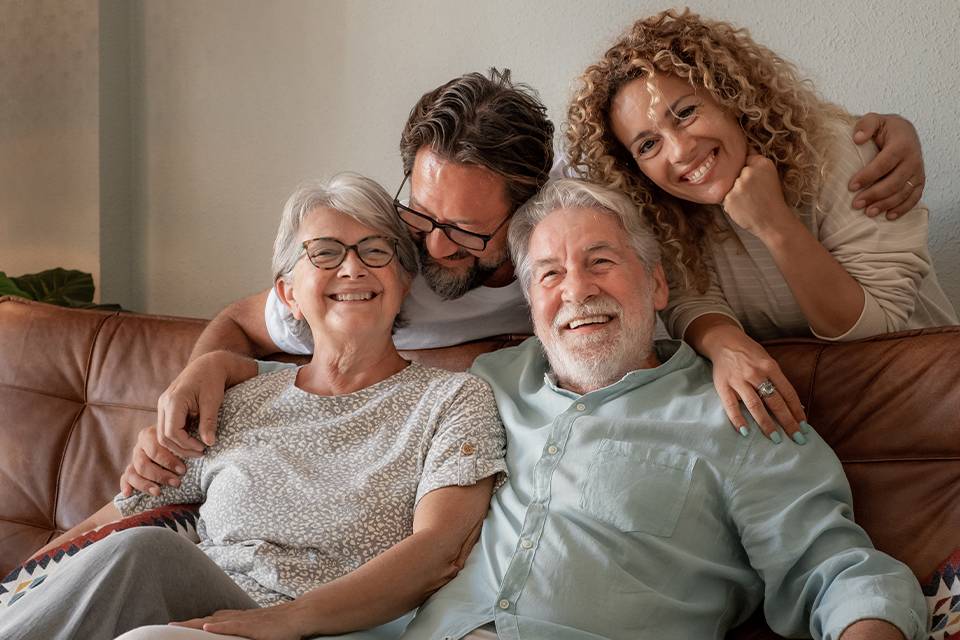
Building a dual occupancy home is an exciting prospect. There is a style to suit everyone, and the advantages are significant. Having two dwellings maximises the value of your land, increases investment return, and can provide accommodation for loved ones. Contact the experts at Forme Homes who will guide you through the dual occupancy process, advise on suitable designs, work out specifications for your block and organise permits and approvals.
Contact
Got a question? Need advice and expertise about new home building, constructing your own plans, developing a block for an investment with duplexes, or multi-unit solutions?
Head Office: 03 8753 9688
What is a Dual Occupancy Home?
The dual occupancy movement is growing across Melbourne, with thousands of people choosing to reconfigure their homes into two distinct dwellings. Simply put, a dual occupancy house is where there are two dwellings on one land allotment. There are two types of dual occupancy – attached and detached. An example of an attached dual occupancy house would be two houses under the same roofline with the same street frontage. An example of a detached dual occupancy house would be one house behind another as a separate structure with a shared driveway.

Difference between Dual Occupancy and Duplex
There seem to be many misconceptions about the difference between dual occupancy and duplex, but, in reality, the distinction is quite simple. They are both two homes on one block, but the construction options and subdivision laws are different.
As stated above, dual occupancy means two homes on one block with one title. A duplex is also two properties on one block but, unlike a dual occupancy, has two separate titles and can be sold separately. A big difference between a dual occupancy and a duplex is a duplex cannot be constructed as a detached dwelling. To qualify as a duplex, the dwellings must be connected by a central wall or roof and yet are legally considered two separate residences. If you build an attached dual occupancy house on a single title of land, you can apply to subdivide that single piece of land into two separate land titles, turning that property into a duplex.

Dual Occupancy Home Designs
There are a number of different designs and styles when considering a new dual occupancy home.
Opting for a higher-density living arrangement is attractive to investors and owner-occupiers, particularly in a competitive rental and real estate climate. The benefits of dual occupancy are numerous. Investors are guaranteed an optimised return on investment, while owner-occupiers can maximise the use of their land, create living space for multiple generations, and reap the financial rewards of sharing the mortgage and living expenses.
Different Ways to Build a Dual Occupancy Home
For anyone wanting to realise the potential of their land and get two houses on one plot of land, it is critical to understand the options for building a dual-occupancy home. Forme Homes offers various alternatives to choose from, including a knockdown rebuild, building a second home on your property, dividing a house into two, or building a new custom dual occupancy home from the ground up.
- Knockdown rebuild. A knockdown rebuild is the process of knocking down and rebuilding a dwelling instead of renovating. You would consider a knockdown-rebuild to build a dual occupancy home if the land value was higher than other places, the block would accommodate two homes, or you wanted to stay in the area. You could knock down the home and rebuild a duplex, townhouse, or two homes on one block of land.
- Building a second home on your property. If your block is suitable, you will have the option of building a second home on your property. Building a second home requires acquiring development permission and other appropriate approvals and can be quite complicated. It is still possible, however, with the help of experts like Forme Homes to guide you through the process. A second home on a property could be a dependent person unit or another dwelling and will still fall under the dual occupancy banner if it is on the one title.
- Dividing a house in two. You can renovate an existing house by dividing it into two or more dwellings. Splitting a home in two could be an option, but it will still require the assistance of a qualified builder and designer to determine the project’s viability and guide you through the building and planning permit application process. Builders like Forme Homes are highly qualified in this conversion style and have a keen eye for maximising this kind of space with the least amount of structural intervention.
- Custom build. By building a purpose-built custom home, you can design and plan your dual occupancy project to your exact specifications. The in-house team of designers and builders at Forme Homes will customise the home to suit your needs while considering the block of land features.




What Is The Process of Building a Dual Occupancy Home?
- Initial consultation with Forme Homes. The initial consultation with Forme is free of charge. Here you will discuss your ideas for the dual occupancy home, potential design options and costs, and your budget to give the team a good understanding of the brief.
- Assess your block. Whether a new block or a block with an existing home, we must establish that dual occupancy is possible and affordable, so a site assessment is necessary. Forme Homes will guide you through the process, evaluating the property, council regulations and codes, and working out how to best maximise your land.
- Design concept plan. After establishing the viability of the building on your block, the Forme in-house design team will work with you to design a floor plan and choose a facade. The experienced team will take into account your requirements as well as the specifications of the block and any council restrictions.
- Sign preliminary contracts. Once you are satisfied with the design and costs, the team will assemble a preliminary contract for you to sign. This allows them to start preparing town planning and conducting land surveys and soil tests.
- Choose external style & colours. As part of the town planning process, final external colours must be chosen. These include the facade, side, and rear of the home. The overall external appearance of the home is finalised to be submitted to the council for approval.
- Sign formal building contracts. Once the town planning is approved and the council’s permits have been obtained, it is time to sign the formal building contract.
- Choose internal fixtures and fittings. With the assurance of council approvals, you can choose your interior colour theme, fixtures, and fittings. For two different homes, you can decide if you want the decor to be the same or choose different colour palettes and interior finishes. If you are planning on living in one of the houses and renting or selling the other, one option is to put higher quality fixtures in your own residence and basic fixtures and fittings in the second dwelling.
For a more in-depth look at the whole design process, please read through our article on the topic here: Designing Your Own Home. - Construction. With a clear lot, the dual occupancy build can begin. Forme Homes project managers work with you throughout the construction process, keeping you informed every step of the way.
For a more in-depth look at the whole build process, please read through our article on the topic here: Stages of Building a Home.

Important Factors To Consider Before Building A Dual Occupancy
With an understanding of the different features of a dual occupancy home, there are several factors still to be considered before choosing a style. Often the type of dual occupancy home you build will be determined by these factors.
- Land size requirements. To build a dual occupancy, blocks typically need to be at least 600 square metres in area and at least 15 metres wide. The different configurations of dual occupancy homes mean the average measurements for a dual occupancy design are required to be 15.25m wide and 44 metres deep.
- Block specifications. The type of development you are allowed to build will depend on the block’s features, including topography, orientation, the streetscape, and the type of buildings abutting the boundary.
- Title & Zoning. The zoning regulations of the council will affect the type of dual occupancy home you can build. Fortunately, most councils allow dual occupancy builds, provided no covenants exist on the land.
- Plans & Permits. Planning documents and building permits are required to build a dual occupancy home. A planning permit allows a certain use or development to proceed on a specified parcel of land which can impact the style of dual occupancy you can build.
- Finance. Avoid over-committing financially by building a style of dual occupancy you can afford. This may impact your choice to build a duplex (which is more affordable) versus two homes on one block.
- Reason for building. Considering the motivation for building a dual occupancy can impact the style you choose. If it is to accommodate grandparents, a dependent person unit or separate house on the same block might be a good option. If it is an investment, perhaps building a duplex is more cost-effective with the likelihood of higher returns.

Frequently Asked Questions
Is building a dual occupancy home a good investment?
Dual occupancy homes are an excellent investment. Having two properties on the one block means twice the rental yield or a better return on selling.
How do I know if my block is suitable for dual occupancy?
The best thing to do is seek advice from the team at Forme Homes regarding council regulations. However, as a rule, block size needs to be on a minimum sized block of 635sqm and have a minimum frontage of 12 metres.
How much does it cost to build a dual occupancy home?
An estimate of the development costs for a dual occupancy home range between $80k – $120k, with building costs on top of that. The full cost will depend on the type of dual occupancy construction, the size of the properties and types of fittings and fixtures chosen.
How long does it take to build a dual occupancy home?
Depending on the development, the timeline varies but, for an average two unit project the estimated time is 18-24 months.
What permits are needed to build a dual occupancy home?
A town planning permit and building permit need to be obtained. The town planning permit is granted from the local council which is written approval saying you are allowed to develop the land in a certain way. The building permit is an approval by a surveyor that the building design complies with building regulations. Forme Homes can advise on permits and approvals and apply on your behalf.
Do you build on flat blocks, or can you build on sloping blocks too?
Dual occupancy homes can be built on sloping blocks, depending on the style and design. Forme Homes can advise on the best site and design for your dual occupancy home.
Which areas do you service?
Forme Homes service Melbourne, south-east Melbourne and the Mornington Peninsula.
Can you use my plans to build?
Forme Homes can use your own plans, and also have a full in-house design team.

Building a dual occupancy home is an exciting prospect. There is a style to suit everyone, and the advantages are significant. Having two dwellings maximises the value of your land, increases investment return, and can provide accommodation for loved ones. Contact the experts at Forme Homes who will guide you through the dual occupancy process, advise on suitable designs, work out specifications for your block and organise permits and approvals.

- WHAT IS IT?
-
What is a Dual Occupancy Home?
The dual occupancy movement is growing across Melbourne, with thousands of people choosing to reconfigure their homes into two distinct dwellings. Simply put, a dual occupancy house is where there are two dwellings on one land allotment. There are two types of dual occupancy – attached and detached. An example of an attached dual occupancy house would be two houses under the same roofline with the same street frontage. An example of a detached dual occupancy house would be one house behind another as a separate structure with a shared driveway.

- DUAL OCC v DUPLEX
-
Difference between Dual Occupancy and Duplex
There seem to be many misconceptions about the difference between dual occupancy and duplex, but, in reality, the distinction is quite simple. They are both two homes on one block, but the construction options and subdivision laws are different.
As stated above, dual occupancy means two homes on one block with one title. A duplex is also two properties on one block but, unlike a dual occupancy, has two separate titles and can be sold separately. A big difference between a dual occupancy and a duplex is a duplex cannot be constructed as a detached dwelling. To qualify as a duplex, the dwellings must be connected by a central wall or roof and yet are legally considered two separate residences. If you build an attached dual occupancy house on a single title of land, you can apply to subdivide that single piece of land into two separate land titles, turning that property into a duplex.

- DESIGNS
-
Dual Occupancy Home Designs
There are a number of different designs and styles when considering a new dual occupancy home.
Opting for a higher-density living arrangement is attractive to investors and owner-occupiers, particularly in a competitive rental and real estate climate. The benefits of dual occupancy are numerous. Investors are guaranteed an optimised return on investment, while owner-occupiers can maximise the use of their land, create living space for multiple generations, and reap the financial rewards of sharing the mortgage and living expenses.
- WAYS TO BUILD
-
Different Ways to Build a Dual Occupancy Home
For anyone wanting to realise the potential of their land and get two houses on one plot of land, it is critical to understand the options for building a dual-occupancy home. Forme Homes offers various alternatives to choose from, including a knockdown rebuild, building a second home on your property, dividing a house into two, or building a new custom dual occupancy home from the ground up.
- Knockdown rebuild. A knockdown rebuild is the process of knocking down and rebuilding a dwelling instead of renovating. You would consider a knockdown-rebuild to build a dual occupancy home if the land value was higher than other places, the block would accommodate two homes, or you wanted to stay in the area. You could knock down the home and rebuild a duplex, townhouse, or two homes on one block of land.
- Building a second home on your property. If your block is suitable, you will have the option of building a second home on your property. Building a second home requires acquiring development permission and other appropriate approvals and can be quite complicated. It is still possible, however, with the help of experts like Forme Homes to guide you through the process. A second home on a property could be a dependent person unit or another dwelling and will still fall under the dual occupancy banner if it is on the one title.
- Dividing a house in two. You can renovate an existing house by dividing it into two or more dwellings. Splitting a home in two could be an option, but it will still require the assistance of a qualified builder and designer to determine the project’s viability and guide you through the building and planning permit application process. Builders like Forme Homes are highly qualified in this conversion style and have a keen eye for maximising this kind of space with the least amount of structural intervention.
- Custom build. By building a purpose-built custom home, you can design and plan your dual occupancy project to your exact specifications. The in-house team of designers and builders at Forme Homes will customise the home to suit your needs while considering the block of land features.




- PROCESS
-
What Is The Process of Building a Dual Occupancy Home?
- Initial consultation with Forme Homes. The initial consultation with Forme is free of charge. Here you will discuss your ideas for the dual occupancy home, potential design options and costs, and your budget to give the team a good understanding of the brief.
- Assess your block. Whether a new block or a block with an existing home, we must establish that dual occupancy is possible and affordable, so a site assessment is necessary. Forme Homes will guide you through the process, evaluating the property, council regulations and codes, and working out how to best maximise your land.
- Design concept plan. After establishing the viability of the building on your block, the Forme in-house design team will work with you to design a floor plan and choose a facade. The experienced team will take into account your requirements as well as the specifications of the block and any council restrictions.
- Sign preliminary contracts. Once you are satisfied with the design and costs, the team will assemble a preliminary contract for you to sign. This allows them to start preparing town planning and conducting land surveys and soil tests.
- Choose external style & colours. As part of the town planning process, final external colours must be chosen. These include the facade, side, and rear of the home. The overall external appearance of the home is finalised to be submitted to the council for approval.
- Sign formal building contracts. Once the town planning is approved and the council’s permits have been obtained, it is time to sign the formal building contract.
- Choose internal fixtures and fittings. With the assurance of council approvals, you can choose your interior colour theme, fixtures, and fittings. For two different homes, you can decide if you want the decor to be the same or choose different colour palettes and interior finishes. If you are planning on living in one of the houses and renting or selling the other, one option is to put higher quality fixtures in your own residence and basic fixtures and fittings in the second dwelling.
For a more in-depth look at the whole design process, please read through our article on the topic here: Designing Your Own Home. - Construction. With a clear lot, the dual occupancy build can begin. Forme Homes project managers work with you throughout the construction process, keeping you informed every step of the way.
For a more in-depth look at the whole build process, please read through our article on the topic here: Stages of Building a Home.

- FACTORS
-
Important Factors To Consider Before Building A Dual Occupancy
With an understanding of the different features of a dual occupancy home, there are several factors still to be considered before choosing a style. Often the type of dual occupancy home you build will be determined by these factors.
- Land size requirements. To build a dual occupancy, blocks typically need to be at least 600 square metres in area and at least 15 metres wide. The different configurations of dual occupancy homes mean the average measurements for a dual occupancy design are required to be 15.25m wide and 44 metres deep.
- Block specifications. The type of development you are allowed to build will depend on the block’s features, including topography, orientation, the streetscape, and the type of buildings abutting the boundary.
- Title & Zoning. The zoning regulations of the council will affect the type of dual occupancy home you can build. Fortunately, most councils allow dual occupancy builds, provided no covenants exist on the land.
- Plans & Permits. Planning documents and building permits are required to build a dual occupancy home. A planning permit allows a certain use or development to proceed on a specified parcel of land which can impact the style of dual occupancy you can build.
- Finance. Avoid over-committing financially by building a style of dual occupancy you can afford. This may impact your choice to build a duplex (which is more affordable) versus two homes on one block.
- Reason for building. Considering the motivation for building a dual occupancy can impact the style you choose. If it is to accommodate grandparents, a dependent person unit or separate house on the same block might be a good option. If it is an investment, perhaps building a duplex is more cost-effective with the likelihood of higher returns.

- FAQS
-
Frequently Asked Questions
Is building a dual occupancy home a good investment?
Dual occupancy homes are an excellent investment. Having two properties on the one block means twice the rental yield or a better return on selling.How do I know if my block is suitable for dual occupancy?
The best thing to do is seek advice from the team at Forme Homes regarding council regulations. However, as a rule, block size needs to be on a minimum sized block of 635sqm and have a minimum frontage of 12 metres.How much does it cost to build a dual occupancy home?
An estimate of the development costs for a dual occupancy home range between $80k – $120k, with building costs on top of that. The full cost will depend on the type of dual occupancy construction, the size of the properties and types of fittings and fixtures chosen.How long does it take to build a dual occupancy home?
Depending on the development, the timeline varies but, for an average two unit project the estimated time is 18-24 months.What permits are needed to build a dual occupancy home?
A town planning permit and building permit need to be obtained. The town planning permit is granted from the local council which is written approval saying you are allowed to develop the land in a certain way. The building permit is an approval by a surveyor that the building design complies with building regulations. Forme Homes can advise on permits and approvals and apply on your behalf.Do you build on flat blocks, or can you build on sloping blocks too?
Dual occupancy homes can be built on sloping blocks, depending on the style and design. Forme Homes can advise on the best site and design for your dual occupancy home.Which areas do you service?
Forme Homes service Melbourne, south-east Melbourne and the Mornington Peninsula.Can you use my plans to build?
Forme Homes can use your own plans, and also have a full in-house design team.
- CONCLUSION
-
Building a dual occupancy home is an exciting prospect. There is a style to suit everyone, and the advantages are significant. Having two dwellings maximises the value of your land, increases investment return, and can provide accommodation for loved ones. Contact the experts at Forme Homes who will guide you through the dual occupancy process, advise on suitable designs, work out specifications for your block and organise permits and approvals.



